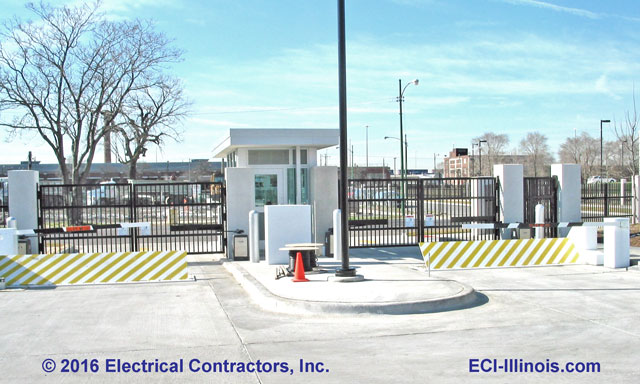The Main Principles Of Wedge Barriers
Table of ContentsThe smart Trick of Wedge Barriers That Nobody is DiscussingThe Single Strategy To Use For Wedge Barriers


18 might be done faster, easily, and price successfully. FIG. In certain embodiments, the support 30 may be a steel structure including plates, beams(e. g., I-beams ), and/or various other frameworks that are protected within the structure 14, which might be concrete. At the surface 12, an upper side 28 of the support 30 might be at least partly exposed
, therefore allowing the attachment of the barrier 10 to the anchor 30. g., threaded holes)in one or more light beams or plates of the anchor 30 may be revealed to the surface 12. In this way, screws 32 or various other mechanical bolts might be used to safeguard the obstacle 10 to the anchor 30. As the obstacle 10 is placed to the surface area 12 of the structure 14, collection of particles and various other material underneath the obstacle may be reduced, and components of the bather 10 may not be revealed to below grade settings. As suggested by reference numeral 52, the training device 50 includes parts disposed underneath the wedge plate 16. For instance, the parts 52 under the wedge plate 16 may include an electromechanical actuator, a camera, one or even more camera surfaces, and so forth. In addition, the lifting mechanism 50 includes a springtime assembly 54
The spring rod 58 is paired to a webcam(e. g., webcam 80 shown in FIG. 4) of the lifting system 50. The springtimes 60 disposed concerning the springtime pole 58 are kept in compression by springtime sustains 62, including a repaired springtime support 64. That is, the set spring support 64 is fixed about the foundation 14 et cetera of the bather 10.
The Facts About Wedge Barriers Revealed
g., spring support 65 )may be dealt with to the end of the springtime rod 58 to make it possible for compression of the springs 60. As the springtimes 60 click this link are compressed between the springtime supports 62, the spring setting up 54 creates a force acting upon the cam combined to the spring pole 58 in a direction 66. As an example, the remaining pressure applied to
the web cam to deploy the wedge plate 16 may be provided by an electromechanical actuator 84 or various other actuator. As such, the springtime setting up 54 and the actuator 84(e. g., electromechanical actuator)may operate with each other to translate the camera and raise the wedge plate 16.
As mentioned above, the spring setting up 54 exerts a continuous force on the cam, while the electromechanical actuator may be controlled to put in a variable force on the web cam, thus enabling the training and lowering( i. e., releasing and retracting )of the wedge plate 16. In specific personifications, the constant pressure applied by the springtime setting up 54 may be adjustable. g., electromechanical actuator) is impaired. As will certainly be valued, the spring assembly 54 may be covered and shielded from debris or various other aspects by a cover plate(e. g., cover plate 68 displayed in FIG. 4) that might be significantly flush with the raised surface area 38 of the foundation 14. As discussed over, in the deployed position, the wedge plate 16 serves to obstruct gain access to or travel beyond the barrier 10. The barrier 10(e. g., the wedge plate 16 )may obstruct pedestrians or cars from accessing a building or pathway. As gone over above, the obstacle 10 is affixed to the anchor 30 protected within the foundation 14,

front braces 71. Consequently, the link assemblies 72 might pivot and revolve to allow the collapse and expansion of the link assemblies 72 throughout retraction and implementation of the bather 10. The linkage settings up 72 reason activity of the wedge plate 16 to be limited. If a car is taking a trip towards the deployed wedge plate 16(e. For instance, in one scenario, the safety and security legs 86 might be expanded duringmaintenance of the barrier 10. When the security legs 86 are released, the safety legs 86 support the weight of the wedge plate 16 against the surface 12. As an outcome, the training mechanism 50 might be deactivated, serviced, eliminated, changed, etc. FIG. 5 is partial viewpoint view of a personification of the surface-mounted wedge-style obstacle 10, showing the web cam 80 and the web cam surfaces 82 of the training system 50. Especially, two camera surface areas 82, which are described as lower web cam surfaces 83, are placed listed below the cam 80. The lower webcam surface areas 83 might be fixed visit homepage to the surface 12 (e. For example, the reduced cam surfaces 83 and the placing plate 85 may create a solitary item that is protected to the anchor 30 by screws or various other mechanical bolts. Additionally, 2 webcam surface areas 82, which are described as upper webcam surfaces 87, are placed over the web cam 80 and coupled to (e. In various other embodiments, stepping in layers or plates may be positioned between the surface 12 and the lower cam surfaces 83 and/or the wedge plate 16 and the upper cam surfaces 87 As mentioned above, the web cam
80 converts along the web cam surface areas 82 when the wedge plate 16 is raised from the withdrawed placement to the deployed setting. In addition, as stated above, the springtime setting up 54 (see FIG. 3 )might offer a force acting upon the webcam 80 in the official site instructions 102 through springtime rod 58, which might minimize the force the electromechanical actuator 84 is called for to put on the camera 80 in order to activate and lift the wedge plate 16. 1 )to the released setting(see FIG. 4). As revealed, the camera 80 consists of track wheels 104(e. g., rollers), which contact and convert along the webcam surface areas 82 throughout procedure.